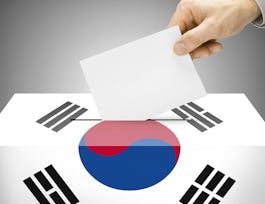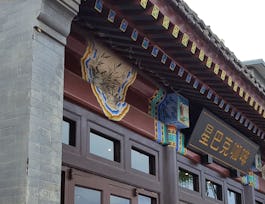You will review the evolution of the Korean economy decade by decade since Korea’s independence from Japan in 1945. Major policies of each decade will be explained and their effect on the Korean economy will be analyzed. Also, the backgrounds and limitations of important policies will be scrutinized. By doing so, you will be able to compare the Korea experience with the other developing countries’.


The Korean Economic Development
Taught in English
Some content may not be translated
17,975 already enrolled
(362 reviews)
Details to know

Add to your LinkedIn profile
8 quizzes
See how employees at top companies are mastering in-demand skills


Earn a career certificate
Add this credential to your LinkedIn profile, resume, or CV
Share it on social media and in your performance review

There are 9 modules in this course
Module 1. Introduction I: This module introduces initial conditions of the Korean economy at the time of independence from Japan in 1945. Upon describing unfavorable initial conditions, it summarizes three major achievements of the Korean economic development after the Korean War (1950-1953). Module 2. Introduction II: In order to explain the determinant factors of the Korean economic success, this module provides two approaches. First, it introduces neoclassical growth model, and explains how each production factor has contributed to economic growth. Second, it introduces institutional approach, which emphasizes the role of the government. Also, it shows the strength and weakness of the Korean economy.
What's included
3 videos1 quiz
Module 3. From independence to the War: After independence from Japan, the newly established Korean government has implemented two meaningful reforms; land reform and educational reform. Main contents and implications of these reforms are explained. This module also introduces economic impact of the Korean War.Module 4. Import Substitution Policy of the 50s: After the Korean War, the Korean government needed to stabilize the hyper-inflation from the mid-1950. Also, IS (import substitution) polices were employed to achieve industrialization and growth. This module introduces major policy tools of IS, and its results.Module 5. The Role of Economic Aid: This module introduces the size and role of economic aids on the Korean economy during the 1950s. It also compares Korea to the other developing countries in terms of aids policies. It also briefly introduces the history of ODA (official development assistance) in Korea.
What's included
5 videos1 quiz
Module 6. Export Promotion of the 60s: From the early 1960s, Korea has changed its development strategy from IS (import substitution) to EP (export promotion). This module introduces backgrounds, major policies, and results of EP policies. Also it compares the Korean experiences of EP to those of Japan. Module 7. Five Year Development Plan and Mobilization of Capital: This module explains how the Five Year Development Plans were launched from the early 1960s. Also, it introduces efforts of the Korean government to mobile capital inside and outside Korea during the 1960s.
What's included
4 videos1 quiz
Module 8. Heavy and Chemical Industrialization (HCI) of the 70s: From the early 1970s, Korea has aggressively pursued HCI (heavy and chemical industrialization) policies. This module explains backgrounds, major policies, and main results of HCI policies.Module 9. Side-effects of HCI and Oil Shocks: This module introduces some side-effects of aggressive HCI (heavy and chemical industrialization) policies. It explains how these side-effects are inter-related with each other. Also, it introduces impacts of oil shocks on the Korean economy during the 1970s, and explains how the Korean economy recovered from oil shocks.
What's included
5 videos1 quiz
Module 10. Crisis Management & Structural Reform and Trade Liberalization of the 80s: The Korean economy was close to foreign exchange crisis in the early 1980s. This module explains how Korea could avoid the crisis and stabilize the economy by the mid-1980s. It also introduces structural reforms and trade liberalization reforms. Module 11. Three Lows & Economic Boom of the 1980s: This module introduces favorable international environments called ‘three-lows’, which emerged from the mid-1980s. It introduces backgrounds of three-lows, and explains how these three-lows helped the Korean economy to enjoy the unprecedented economic boom. Also, it introduces how the democratization of the Korea society has influenced the economy.
What's included
3 videos1 quiz
Module 12. The Early 1990s: In the early 1990s, the Korean economy has faced the end of high growth era. However, the Korean economy has failed to adapt itself to slower growth, and the problem of ‘high costs and low efficient’ economic structure emerged.
What's included
1 video1 quiz
Module 13. 1997 Asian Financial Crisis I: In the end of 1997, the Korean economy fell into foreign exchange crisis and had to be bailed out by IMF (international monetary fund). This module explains the internal and external causes of the 1997 Asian Financial Crisis. Module 14. 1997 Asian Financial Crisis II: In order to recover from the 1997 Asian Financial Crisis, the Korean government and IMF implemented four major reforms in the area of financial sector, corporate sector, labor market, and government. This module introduces main contents of these reforms, and explains how they helped the Korean economy to recover from the crisis. Module 15. 1997 Asian Financial Crisis III: This module introduces some side-effects and controversial issues with respect to the 1997 Asian Financial Crisis. Also, it explains about implications of the 1997 crisis on the Korean economy.
What's included
4 videos1 quiz
Module 16. 2008 Global Financial Crisis & Beyond: In September, 2008, the global economy fell into financial crisis after the collapse of Lehman Brothers. This module explains how the 2008 global financial crisis affected Korea, and also explains how Korea has recovered from it. Module 17. 2008 Global Financial Crisis & Beyond: This module introduces implications of the 2008 global financial crisis on the Korean economy. Also, it shows the most recent picture of the Korean economy by introducing strength and weakness of the Korean economy.
What's included
5 videos1 reading1 quiz
What's included
1 peer review
Instructor

Offered by
Recommended if you're interested in Economics

Yonsei University

Sungkyunkwan University

Yonsei University

Yonsei University
Why people choose Coursera for their career




Learner reviews
Showing 3 of 362
362 reviews
- 5 stars
83.51%
- 4 stars
14.56%
- 3 stars
1.09%
- 2 stars
0.54%
- 1 star
0.27%

Open new doors with Coursera Plus
Unlimited access to 7,000+ world-class courses, hands-on projects, and job-ready certificate programs - all included in your subscription
Advance your career with an online degree
Earn a degree from world-class universities - 100% online
Join over 3,400 global companies that choose Coursera for Business
Upskill your employees to excel in the digital economy
Frequently asked questions
Access to lectures and assignments depends on your type of enrollment. If you take a course in audit mode, you will be able to see most course materials for free. To access graded assignments and to earn a Certificate, you will need to purchase the Certificate experience, during or after your audit. If you don't see the audit option:
The course may not offer an audit option. You can try a Free Trial instead, or apply for Financial Aid.
The course may offer 'Full Course, No Certificate' instead. This option lets you see all course materials, submit required assessments, and get a final grade. This also means that you will not be able to purchase a Certificate experience.
When you purchase a Certificate you get access to all course materials, including graded assignments. Upon completing the course, your electronic Certificate will be added to your Accomplishments page - from there, you can print your Certificate or add it to your LinkedIn profile. If you only want to read and view the course content, you can audit the course for free.
You will be eligible for a full refund until two weeks after your payment date, or (for courses that have just launched) until two weeks after the first session of the course begins, whichever is later. You cannot receive a refund once you’ve earned a Course Certificate, even if you complete the course within the two-week refund period. See our full refund policy.


